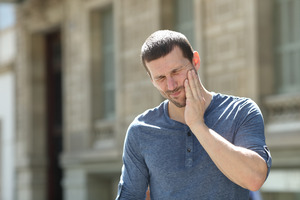
In order to treat your TMJ disorder and find lasting relief from your jaw pain, you need to understand what could be causing the problem in the first place. There are many possible risk factors to consider, but one that often gets overlooked is posture. Believe it or not, the way you stand, walk, or sit can end up having an impact on your jaw. Below is a closer look at the relationship between posture and TMJ disorder as well as what you can do about it.
What Exactly is a TMJ Disorder?
TMJ is short for “temporomandibular joint.” This is the name of the joint that sits just in front of the ear and allows you to move your lower jaw. If a TMJ is overworked or injured, it can lead to a TMJ disorder, which is often characterized by jaw pain, headaches, ringing in the ears, difficulty chewing, and other unpleasant symptoms.
How Can Bad Posture Lead to a TMJ Disorder?
The position of your neck and shoulders can have an effect on your jaw joints. When you slouch or stick your head too far forward, it changes the position of your lower jaw, which in turn can put an excessive amount of pressure on your TMJs. As time passes, said pressure could eventually result in a TMJ disorder or make already existing symptoms worse.
How Can You Improve Your Posture to Address Your TMJ Disorder?
Correcting your posture can go a long way toward reducing the pressure on your jaw joints and helping you relieve your TMJ-related pain. Here are a few simple changes that can help:
- Focus on keeping your back straight while you’re walking. Avoid slouching, and keep your shoulders pushed back. It often helps to imagine that there is a book balanced on your head.
- Do not lean forward while sitting down; instead, make a conscious effort to keep your back pressed against your chair. It may also help to get a small pillow to support your lower back.
- If you often work on a laptop, keep it at eye level. That way, you won’t have to move your head forward to look at the screen.
- Make a conscious effort to get up and move around every half hour or so. This will help ensure that your body doesn’t remain in the same position for too long.
While correcting your posture is no substitute for professional treatment, it can nevertheless be an important step for addressing your TMJ disorder and putting a stop to your jaw pain.
About the Author
Dr. Haiwen Zhang studied dentistry at the Medical University of South Carolina James B Edward College of Dental Medicine. He continues to expand his dental knowledge and skills via continuing education courses from the Pankey Institute and Spear Education. At Juniper Dental in Santa Fe, he’s able to help patients find relief from TMJ disorders with customized mouthguards. If you’re bothered by chronic jaw pain, you can schedule a consultation with Dr. Zhang by visiting his website or calling (505) 372-1121.
